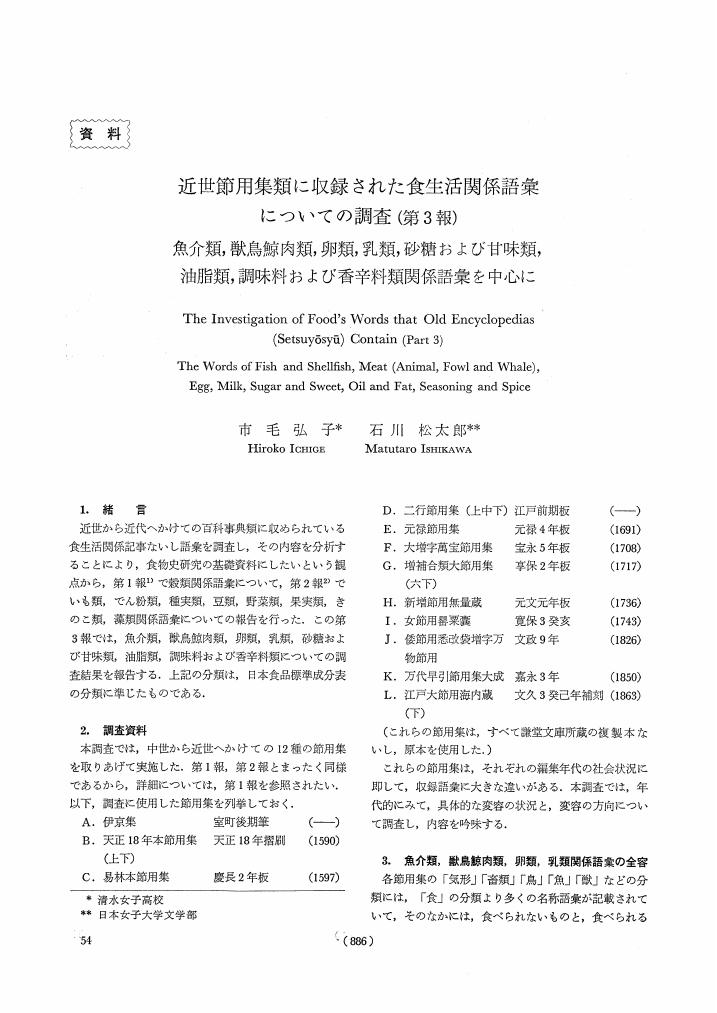5 0 0 0 OA 近世を中心として
- 著者
- 市毛 弘子
- 出版者
- The Japan Society of Home Economics
- 雑誌
- 家政学雑誌 (ISSN:04499069)
- 巻号頁・発行日
- vol.37, no.6, pp.465-473, 1986-06-20 (Released:2010-03-10)
- 参考文献数
- 11
“Sakubei” was imported from China to Japan with Buddhism in the Ancient Times. It was made from wheat flour and rice powder, and was eaten with salt, vinegar, Miso and Hishio. It had been called “Muginawa” from the Ancient Times on to the 13th century, but very often it was called “Sakubei” in the Middle Ages. It was made certain that the custom of eating Sakubei on the 7th July had been carried on since the end of Heian era, and continued to the Middle Ages. Moreover it was kept on to the 17th century in the Imperial Court. Soumen became known as food of tea ceremony in the 14th century. Priest of temples ate it between meals, which was called “Tenjin.”By and by Soumen became widely used as food. Sakubei however, was not eaten by many people except high society people. Until the 17th century Soumen and Sakubei were different kinds of food. But afterwards people became to think that Sakubei, Muginawa and also Soumen were all the same things. The reason is supposed as follows : Some investigations published books concerning such kinds of food without satisfactory explanation because of the lack of enough study about the old documents.
1 0 0 0 OA 古代・中世
- 著者
- 市毛 弘子
- 出版者
- The Japan Society of Home Economics
- 雑誌
- 家政学雑誌 (ISSN:04499069)
- 巻号頁・発行日
- vol.37, no.6, pp.453-463, 1986-06-20 (Released:2010-03-10)
- 参考文献数
- 14
It was found by my investigation that the word “Muginawa” meaned “Sakubei” at first, and it changed into “Soumen” in the Edo era. So, I tried to research for its origin, as well as the way of use, and the process of change from Sakubei to Soumen.In China, Sakubei was eaten before 220 A.D. In Japan, some data can be found indicating that it was eaten at the Todaiji Temple in the early days of the Nara era. From these facts, it is supposed that Sakubei was imported from China along with Buddhism, and sold at East and West markets of Heijokyo.In the Heian. era “Sakubei” was very important food in the Imperial Court. It was given to the priests and high society people from the Emperor at the Imperial events.“Sakubei” was served at the first step of dinner table. After ear shell's soup was served to the Emperor it was taken off the table. It came into wide use at the end of the Heian era. High society people had a custom of eating Sakubei on the 7th July according to an old Chinese tradition.From the ancient times on to the 13th century it had been called “Muginawa, ” but in the Middle Age it was very often called “Sakubei.” The custom of eating Sakubei on the 7th July was continued from the end of Heian era to the Middle Ages.On the other hand Soumen became known as food of tea ceremony in the 14th century. It was called “Tenjin, ” which gradually spread wide among priests of temples as their between-meals. It soon became generalized, but Sakubei was not eaten by many people except high society people. It is clear, however, that Soumen and Sakubei were different at all from each other at that time.
1 0 0 0 OA 近世節用集類に収録された食生活関係語彙についての調査 (第3報)
- 著者
- 市毛 弘子 石川 松太郎
- 出版者
- The Japan Society of Home Economics
- 雑誌
- 家政学雑誌 (ISSN:04499069)
- 巻号頁・発行日
- vol.35, no.12, pp.886-898, 1984-12-20 (Released:2010-03-10)
- 参考文献数
- 21
